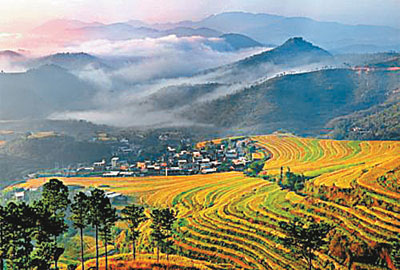 The China Institute of City Competitiveness recently published the ranking list of China’s Most Beautiful Counties of 2014. Yangshuo, in the Guangxi Zhuang Autonomous Region, was the first on the list. Dabu is the only county in Guangdong included on the list. According to the institute, the selection was based on the counties’ developments in city planning, traditional culture, special architecture, rural customs, natural resources and public reputation. This week, we will set off to Dabu to discover the beauty of Guangdong Province. A famous Meizhou city Dabu County is administered by the city of Meizhou. Far away from the frenetic pace of Guangdong’s industrial cities, Dabu offers an enchanting escape to another world of lush forests, waterfalls and distinctive historical architecture. Over the years, Dabu has had dozens of titles bestowed upon it, such as “China’s Most Influential Cultural Tourism County,” “China’s Top 10 Cultural Recreation Bases,” “Top 10 Beautiful Towns of China,” “China’s Distinctive Vacation Resort” and “Grand View of the Hakka Dwellings.” Shangri-La of the Hakka world Dabu boasts a clean environment with almost no pollution. It has beautiful scenery and a forest coverage rate of 74.9 percent. It also has six nature reserves and 16 forest parks. The magnificent and beautiful Xiyan Mountain and the towering Yinna Mountain are both ideal places for people to enjoy beautiful scenery. Other sites include the terraced rice fields, forest parks, wide mountain ranges, temples that date back more than 1,000 years and crystal-clear rivers where you can see swimming fish and stones that line the riverbed. All of this in addition to Dabu’s rich Hakka heritage have helped Dabu earn the nickname “Shangri-La of the Hakka world.” Dabu’s Pingshan terraced fields were formed over 400 years in response to the scarcity of flat farmland. Covering more than 80 hectares, the terraces resemble crescent mirrors when they are irrigated with water. In March, April, July and August, the water-filled fields glisten under the sun and reflect as silver in the moonlight. Rich Hakka culture The county’s Hakka earthen buildings are considered a wonder of Oriental architecture. Ancient Chinese considered the sky round and the earth square, so many of the Hakka buildings here are round or square to represent the earth and sky. Made of rammed earth and timber with very thick walls, they were built to provide a defense against enemies, bandits and even beasts. The buildings, generally built in an eight-trigram battle array, have many advantages — they are virtually quakeproof, fireproof and safe from theft. A masterpiece is the Hua’e Building in the county’s Dadong Town. The 400-year-old building, covering an area of 2,300 square meters, is one of the largest of its kind in Guangdong Province. The 11.9-meter-high, three-ring structure is round, made of adobe and wood, and has 210 rooms. The county also has numerous ancient residential buildings, including the ancestral homes of Singapore’s Minister Mentor Lee Kuan-yew, its Prime Minister Lee Hsien-loong and Chang Bishi, an overseas Chinese who founded China’s wine industry. A frequent stopover is Gaobi Town, where visitors learn about the county’s ceramic traditions and latest achievements. The county can trace its pottery and porcelain production back more than 700 years. It makes not only ceramic products for daily use, but also supplies ceramic products for ornaments. Recommended traditional Hakka dishes in Dabu include salted chicken, homemade pork soup, Hakka-style tofu stuffed with pork meat, local rice noodles, pork meatballs and pancake rolls. Transport: Take a long-distance coach to Dabu from coach stations in Shenzhen, and take a taxi to various scenery spots. (Wang Yuanyuan) | 
